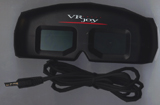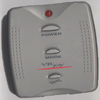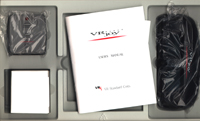
The unofficial VR-JOY
page
maintained by
Christoph Bungert
This page was innitially
released on May 30, 1998,
last update: September 10,
1998.
Quick info:
The VR-Joy by VR
Standard Corp (manufactured by Woobo)
is a wired 3D-Shutterglasses system for any hardware platform. It features
a VGA-pass-through controller which syncs to any (!) screen mode. In addition
it has a switchable "Line Blanker" device
which generates artificial interlace in conjunction with any (!) graphics-board.
No driver software required. The VR Joy is 100% compatible to any computer
and graphics hardware as long as a standard monitor (no LCD) is used. Software
compatibility includes all frame and line sequential titles. The above-below
split-screen format is NOT supported. The package comes without any software,
but usually customers receive a 1 month membership for the VR-Joy
(adult-) website.
From 1999 on the VR-Joy will be bundled
with the full retail version of Hexen2.
My verdict: The best buy so far, apart
from the 3Dfx-gaming focused H3D/Wicked3D products.
New: A
competitor entered the market offering similar features. The Tetratel EyeFX.
You may like to read the VR-Joy vs. EyeFX shootout
and the EyeFX review.
This review isn't
intended for beginners. Please consult the Basics
and FAQ pages first.
Related Links:
VR-Standard
Vr-Joy.com
Woobo (manufacturer)
Brenner&Sievritts
(german distributor)
vrjoy.de
(german distributor)
3DIST
(german distributor)
Official
Brasilian VRJoy site
Join
VR-Ring

a
member of VR-Ring



First of all the VR Joy controller uses a VGA-pass-through cable
and behaves exactly like my beloved homebrew VGA-PT
circuit.
The controller just syncs to anything (page-flipping and interlace).
In addition it has a switch to activate "line-blanking" which
provides interlace in any case, even on VGA-boards which usually don't
support this.
There is no sync-doubler functionality for the split-screen-format
though.

The VGA-dongle fits between VGA-card and monitor. Despite the fact that
complex circuitry is involved the dongle is very small opposed to the oversized
H3D-dongle. The circuitry resides in the external controller box.
This leads to the next question. What about VGA-signal quality loss?
That's hard to tell. In theory there's always some loss when using VGA-dongles,
but it's not severe in this case.
The box has two standard 3.5 mm stereo jacks (headphone format) for
wired shutterglasses. Using standard headphone adaptors more than 2 glasses
should also be possible.
I tried the 3D-Max glasses with the controller. No problems here, looks
like the LCD's come from the same manufacturer. The 3D-SPEX glasses work
too.
WARNING: Unfortunately
the wiring of the VR Joy glasses is reversed compared to some other brands
of wired glasses. When connecting the VR Joy and some 3D-Max or 3D-SPEX
glasses simultaneously one goggle will work correctly, while the other
is in Stereo-Reverse !!!
Countermeasures: Use two glasses with the same wiring or build
a little 3.5 mm adaptor which reverses the contacts (very simple). Check
the homebrew section for details on the 3.5
mm jack pinout.
NEW: Another problem: I was told
that the VR-Joy controller uses a nasty control signal format which might
hurt some 3rd party glasses. The liquid crystals could migrate. No danger
for the Spex though.
The cable between dongle and controller-box is 190 cm long (manufacturer
claims 200 cm), that's good. The controller resides on the desk like a
mouse and has 3 buttons, which give the user total control - just as it
should be.

The 3 buttons:
POWER: Glasses on/off
MODE: Auto-Sync/Line-Blanker
<=>: Stereo-Reverse
Will it work for 3Dfx Voodoo Graphics and Voodoo 2 add-on boards?
Yes, but there's no software yet. The images would have to be in interleaved
line format. The split-screen format as it is used by H3D is NOT supported.
In theory it would be very easy for a programmer to modify such programs
to display interleaved format instead of split-screen.
On Voodoo Rush or Rendition boards H3D titles will work right away
with the VR Joy.
Always check the stereo orientation by using
the reverse-switch at startup (and from time to time during a page-flipping
-i.e. LCD-BIOS- stereo-session). Using LCD-BIOS the stereo orientation
can change every second and render the software useless.
Beginners can easily miss the fact that the
image is reversed, which results in eye&brain-strain and an unsatisfying
3D-experience.
Power

The controller is powered by an external adaptor. Too bad they didn't
do the i-Art trick with the keyboard connector.
I received the 110V version. According to the package there should be a
220V version also. The output specs are: 9V, 200mA.
Documentation

Poor! There's a little booklet which just covers the basics of operation
and a small list of related web-sites. The LCD-BIOS homepage and my homepage
are missing. No information on 3D-basics, photography, programming, etc.
No introduction to the technical principles: interlace, page-flipping,
line-blanking.
Like the H3D system the VR Joy features circuitry which I refer
to as "Line Blanker". Opposed to H3D the control of the device lays in
the hands of the user, which is GREAT !!! No proprietary software
required. Just a push of a button and you're done. After fiddling around
with 3D- and VESA-drivers for so long it feels like magic!
The VR Joy was in development long before the H3D came out. Woobo hoped
to be the first to present this technology. When the H3D line blanker technology
was revealed on this website it came as a bad surprise to Woobo.
The VR-Joy line-blanker seems to be more flexible compared to the H3D
when it comes to resolution/refresh-rate compatibility. The H3D line-blanker
only works on certain settings.
The Line Blanker works on any software which provides an interleaved
line stereo-3D image format.

interleaved line stereo format
Usually driver software and a compatible VGA-chipset is required
to display such an image in a shutterglasses-compatible way.
With the Line Blanker you don't need any software or any special VGA-hardware.
What the line blanker does:
VGA card and monitor are in a normal mode. Resolution & refresh
are normal, but your eyes see interlace.
How is this done?
Here you go: The controller scans the frame and blanks out the odd lines.
In the next frame the controller blanks out the even lines
and so on. The refresh rate and other parameters aren't changed. The
lines are still there, they're just black now. This is not even
page-flipping. It's what I would call "synthetic interlace", without
the participation of VGA-card or monitor.
Graphics mode compatibility
The manual claims that the Line Blanker is optimized for 800x600,
but I've tested many more modes, without any (obvious) problems:
320 x 200 @ 51 Hz
320 x 200 @ up to 159 Hz
640 x 480 @ up to 160 Hz
800 x 600 @ up to 137 Hz
1024 x 768 @ up to 107 Hz
1152 x 864 @ up to 94 Hz
1280 x 1024 @ up to 75 Hz
1600 x 1200 @ up to 57 Hz
Tested with Matrox Mystique 220, IDEK 86 kHz monitor and Scitech Display
Doctor.
You see, the only limit seems to be my humble monitor - amazing!
Ohh yes, and the most important:
3Dfx Voodoo Graphics: 640 x 480 @ 120 Hz - no problems!
(Please remember that there's no interleaved line stereo 3Dfx software
yet! H3D stuff doesn't work in this case! )
Drawbacks of the Line Blanker !!!
1) Possible inaccuracies in the blanking process might lead to additional
ghosting or other unwanted effects when using other resolutions than the
recommended 800 x 600 ?!? (I have to further investigate this, but there
seem to be no problems at least with my hardware.)
2) The impact on the monitor frequency is 2 times as high as real
interlace, at the same resolution & refresh.
3) The image might be slightly darker than in real interlace.
4) The problem of the black interlace lines remains, line-doubled
page-flipping just looks better.
5) Refresh rate isn't changed. Setting has to be done manually
using 3rd party utilities, like Scitech Display Doctor.
Remember:
The VR-Joy minus the Line-Blanker equals an autosync system similar
to APEC VR97, i-Art VirtualEyes or the homebrew VGA-PT. You know I like
these systems, so I like the VR-Joy even more.
The Line Blanker uses standard screen modes. It doesn't change the
refresh rate, like a real interlace driver (3D-BIOS, VR-BIOS, 3D-Win,
etc.).
In case you can get your hands on any real interlace
driver (like i-Art 3DWin, APEC VR(97)-Viewer, Stereographics
SG-Toggle, VRex VR-BIOS, VRex SSDI) which works for your particular
VGA-board you might use this instead of the Line-Blanker. Real interlace
provides higher refresh and puts less pressure on your monitor.
On the other hand: It's much more fun to just push the MODE-button
than to fiddle around with drivers. AND... most important: many of the
newest, hottest VGA-boards are not supported by current driver software
and never will be, because they don't do interlace anymore.
Some programs (games to be precise) require a 3D-driver like LCD-BIOS
or VR-BIOS.
When using LCD-BIOS or native SimulEyes titles with the VR Joy the
usual drawbacks (instable stereo orientation)
apply.
When using the Line-Blanker use Scitech Display Doctor or a similar
tool to set the refresh rate as high as possible!
The same applies in case the VR Joy is used with LCD-BIOS, NuvFrag
or native SimulEyes titles.
In case the VR Joy controller stops working at a certain refresh rate
use Display Doctor to change the sync polarity !!!
Unfortunately there are many programs using standard VGA modes instead
of VESA which might get you stuck at 70 Hz.
(Try the LCD-BIOS hi-refresh command line option in this case.)
Don't forget to deactivate the Line-Blanker when using a 3D-Driver or
a native SimulEyes or H3D title.

The VR Joy glasses are wired and weight 90 g. They
seem to be similar to the Woobo
Cyberboy, but the walkman-type earphones are gone, which isn't of any concern
in my opinion. The holders for the earphones are still present. There's
also a (new ???) adjustable and removable nose-piece which is quite comfortable,
much better than the 3D-Max nose-piece. The glasses should fit over any
prescribed glasses, but the nose-piece has to be removed in this case.
Comfort with prescribed glasses is also acceptable.
Due to my big head (circumference 61 cm) I'm on the threshold of the
VR Joy's size. There's already a bit of painful pressure behind the ears.
Usually this shouldn't be of any concern, since most heads are smaller
:-).
The stereo-reverse switch in the cable has gone also. The reverse button
can now be found on the controller.
VR Standard Corp./Woobo claim a maximum refresh rate of 180
Hz. I've tested them at up to 160 Hz. No problems.
The LCD-panels are large: 4 x 2.5 cm. Good!
The cable length is 180 cm (the manufacturer claims 200 cm).
That's more than enough since the controller resides on the desk. The cable
is thick and flexible.
Please check the X-RAY Lab for a weight&size
comparison of various shutterglasses.



I found this order-form, in the VR Joy package, which might be of interest.
I don't think all items are available already.
The software prices are quite reasonable. Maybe they're only available
to VR-Joy customers.
Keep an eye on the VR
Standard webpage if you're interested.
Due to the Line-Blanker device the VR Joy is 100% compatible
to any computer system and any graphics hardware. It'll work with any standard
tube-monitor or -projector (not LCD!!!) which is connected via a standard
15-pin jack.
As far as I know the VR Joy is 100% hardware compatible
(not neccessarily software compatible, since some drivers are not available
for free) to the following shutterglasses systems and HMD's (apart from
the known drawbacks):
-
3DTV 3D Magic
-
3DTV 3D PCTV
-
Nuvision 3D-SPEX
-
Cyberstuff Cyber3DVisor
-
Woobo Cyberboy
-
Chinon Cybershades
-
Stereographics SimulEyes
-
VRex VRSurfer
-
miro 3Dfanatix
-
APEC Virtual Visor
-
APEC VR97
-
i-glasses
-
CyberMaxx
-
homebrew controllers: serial, parallel, VGA-PT
The VR Joy is only partially compatible to the following
devices (depending on the VGA-chipset, 3D-driver and software used)
-
Kasan 3D-Max
-
H3D Eyewear
-
VFX-1
-
Canopus Total3D
The VR Joy is compatible to any software which delivers an interleaved
line or page-flipping format.
No driver required.
A standard web-browser or slideshow program is sufficient for viewing
stereo-images.
VR Joy will work for any operating system (Windows, DOS, Mac, Unix,
whatever).
Apart from that the VR Joy controller should work with the following
driver-software:
-
LCD-BIOS (apart from the known drawbacks)
-
Nuvision NuvFrag (apart from the known drawbacks)
-
Nuvision WinSPEX (apart from the known drawbacks)
-
i-Art 3DWin
-
APEC VR(97)-Viewer
-
Stereographics SG-Toggle
-
VRex VR-BIOS
-
VRex SSDI
-
VESA3
-
The VR Joy works also for programs which invoke interlace or page-flipping
by themselves, like SimulEyes titles or, in some cases, H3D-titles
All drivers are copyrighted. All drivers, except the VRex and i-Art drivers
are available on the internet. Click here for
driver-overview and -links. VRex SSDI will be available on the
net someday I hope.
Incompatibilities:
-
split-screen format isn't supported (like H3D titles on Voodoo Graphics
& 2)
-
Kasan 3D-BIOS can be used with the VR Joy hardware, but the Kasan
3D-Max ISA card still has to be installed!
-
HMD software, especially titles for the VFX-1, might check for the presence
of the particular hardware
3D-Movies:
The manufacturer claims that the VR Joy will be compatible to any Movie
format. Well, there is no TV-adaptor in the package which means it won't
work for 3D-movies on VHS tape. The upcoming DVD movies for the PC, as
announced by H3D and other companies, might be in split-screen format,
rather than interleaved line format. Let's hope there will be MPEG movie
player software which provides both formats.
Update: There are some MPEG1 and
AVI video clips in interleaved 3D format on the VR
Standard Homepage. They work on any standard player software, but can't
be zoomed. Enlarged or full-screen video playback would require special
software which handles the lines correctly.
The VR-Joy website:
The VR-Joy website offers adult and other image material for stereo
viewing. The only thing I saw was the preview stuff. It seems they're using
JPG-files in interlace format. The JPG-compression algorythm doesn't behave
well with such material, which might lead to additional ghosting. It's
always better to isolate the left and right image information better when
using compression. An example of how it's done right is the JPS (JPG Stereo
format).
I must admit that I'm using standard interleaved JPG format too, even
on this website, because handling is so easy.
|
VR Joy game compatibility
|
Check the compatibility chart for VR-Joy,
EyeFX and other line-blanking devices.
Special thanks to Woobo
for providing me with a free VR Joy sample.


Join
VR-Ring

a
member of VR-Ring
|
Please consult the Shutterglasses
Comparison
Chart for a complete market-overview.
|
Brand and product names are trademarks or registered trademarks of their
respective holders.
The author can not guarantee the accuracy or topicality of the information
given on this page.
Christoph Bungert, Germany .









